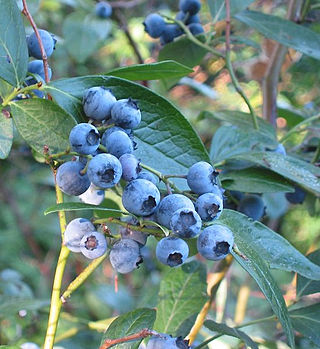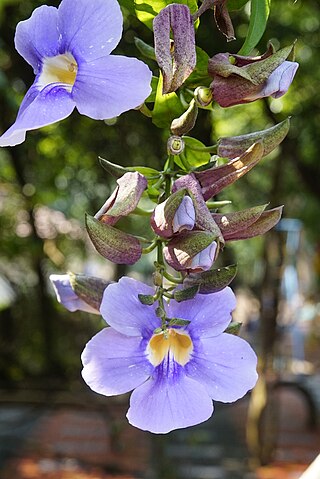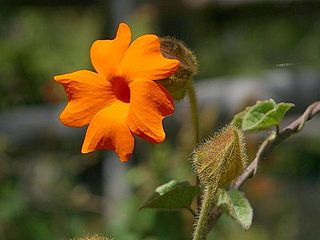
Justicia brandegeeana, the Mexican shrimp plant, shrimp plant or false hop, is an evergreen shrub in the genus Justicia of the acanthus family Acanthaceae, native to Mexico, and also naturalized in Florida.

Tradescantia pallida is a species of spiderwort native to the Gulf Coast region of eastern Mexico. The cultivar T. pallida 'Purpurea' is commonly called purple secretia, purple-heart, or purple queen. Edward Palmer collected the type specimen near Ciudad Victoria, Tamaulipas in 1907.

Abutilon pictum, syn. Abutilon striatum (disputed), is a species of flowering plant in the family Malvaceae. It is native to southern Brazil, Argentina, Paraguay and Uruguay. The plant has become naturalised in Central America, and is used in horticulture. Common names include redvein abutilon, red vein Indian mallow, redvein flowering maple, Chinese-lantern and red vein Chinese lanterns.

Thunbergia is a genus of flowering plants in the family Acanthaceae. It includes 150 species native to tropical and subtropical regions of sub-Saharan Africa, Madagascar, southern Asia, New Guinea, and Australia. Thunbergia species are vigorous annual or perennial vines and shrubs growing to 2–8 m tall. The generic name honours the Swedish naturalist Carl Peter Thunberg (1743-1828).

Aglaonema is a genus of flowering plants in the arum family, Araceae. They are native to tropical and subtropical regions of Asia and New Guinea. They are known commonly as Chinese evergreens.

Lavandula angustifolia, formerly L. officinalis, is a flowering plant in the family Lamiaceae, native to the Mediterranean. Its common names include lavender, true lavender and English lavender ; also garden lavender, common lavender and narrow-leaved lavender.

Vaccinium corymbosum, the northern highbush blueberry, is a North American species of blueberry. Other common names include blue huckleberry, tall huckleberry, swamp huckleberry, high blueberry, and swamp blueberry.

Justicia floribunda is a species of flowering plant in the acanthus family Acanthaceae, native to southern Brazil, Paraguay, and Misiones Province of northeastern Argentina.

Thunbergia alata, commonly called black-eyed Susan vine, is a herbaceous perennial climbing plant species in the family Acanthaceae. It is native to Eastern Africa, and has been naturalized in other parts of the world.

Thunbergia laurifolia, the laurel clockvine or blue trumpet vine, is native to India and Thailand and the Indomalayan realm, the species occurs from Indochina to Malaysia.

Heptapleurum actinophyllum is a tree in the family Araliaceae. It is native to tropical rainforests and gallery forests in northern and north-eastern Queensland coasts and the Northern Territory of Australia, as well as New Guinea and Java. Common names include Australian umbrella tree, Queensland umbrella tree, octopus tree and amate.

Verbena bonariensis, the purpletop vervain, clustertop vervain, Argentinian vervain, tall verbena or pretty verbena, is a member of the verbena family cultivated as a flowering annual or herbaceous perennial plant. In USA horticulture, it is also known by the ambiguous names purpletop and South American vervain. For the misapplication "Brazilian verbena" see below.

Linaria maroccana is a species of flowering plant in the plantain family known by the common names Moroccan toadflax and annual toadflax. It is native to Morocco, but it can be found elsewhere growing wild as an introduced species, such as California. It is a readily available ornamental plant for the flower garden. This is an annual herb growing erect to approach a maximum height of 50 cm (20 in), its stem with linear leaves 2–4 cm (0.8–1.6 in) long. The inflorescence is a raceme of flowers occupying the top of the stem. At the base of each flower is a calyx with five narrow, pointed lobes. The flower is 2–4 cm (0.8–1.6 in) long with five lobes arranged into two lips with a spur at the end. The flower is often purple in color with white near the throat, but flowers of many different colors are bred for the garden. Dwarf cultivars are also available.

Vitis coignetiae, called crimson glory vine, is a plant belonging to the genus Vitis that is native to the temperate climes of Asia, where it can be found in the Russian Far East, (Sakhalin); Korea; and Japan. It was described botanically in 1883. It is called meoru (머루) in Korean and yama-budo (ヤマブドウ) in Japanese.

Thunbergia erecta, commonly known as the bush clock vine or king's mantle, is a vibrant, evergreen species of shrub in the family Acanthaceae. Native to the forest zone stretching from Guinea-Bissau to western Cameroon, it has found significant cultivation worldwide due to its ornamental appeal and versatility. The plant is particularly known for its erect or scandent growth habit, reaching a notable height of up to five meters or more. This robust shrub displays a fascinating range of pale to dark violet-purple flowers that contribute to its visual appeal and broad popularity. Each flower measures between 5.0 to 7.5 cm in length, hosting a stark white tube at their core. This striking color contrast lends an undeniable charm to the plant, making it a favored choice in various garden settings and landscapes.

Galega, goat's rue, is a genus of flowering plants in the legume family, Fabaceae, native to central and southern Europe, western Asia and tropical east Africa. They are tall, bushy, herbaceous perennials with erect racemes of pea-like flowers in shades of white, pink, blue or mauve. Their preferred habitats are sunny damp meadows or slopes.

Thunbergia grandiflora is an evergreen vine in the family Acanthaceae. It is native to China, India, Nepal, Bangladesh, Indochina and Myanmar and widely naturalised elsewhere. Common names include Bengal clockvine, Bengal trumpet, blue skyflower, blue thunbergia, blue trumpetvine, clockvine, skyflower and skyvine.

Thunbergia fragrans, the whitelady is a perennial climbing twiner in the family Acanthaceae, native to South and Southeast Asia and China.

Thunbergia gregorii, commonly known as orange clockvine or orange trumpet vine, is a herbaceous perennial climbing plant species in the family Acanthaceae, native to East Africa and sometimes cultivated as an ornamental vine. The bright, pure all-orange flowers distinguish it from the related black-eyed Susan vine.

Thunbergia battiscombei, also known as the blue glory vine, is a species of flowering plant within the family Acanthaceae. It is sometimes used as an ornamental garden plant for its beautiful large blooms and leafy foliage. Thunbergia battiscombei is also cultivated as a herb within its native range. Some people superstitiously believe the herb is able to help remedy mental imbalance, curses and black magic.
























